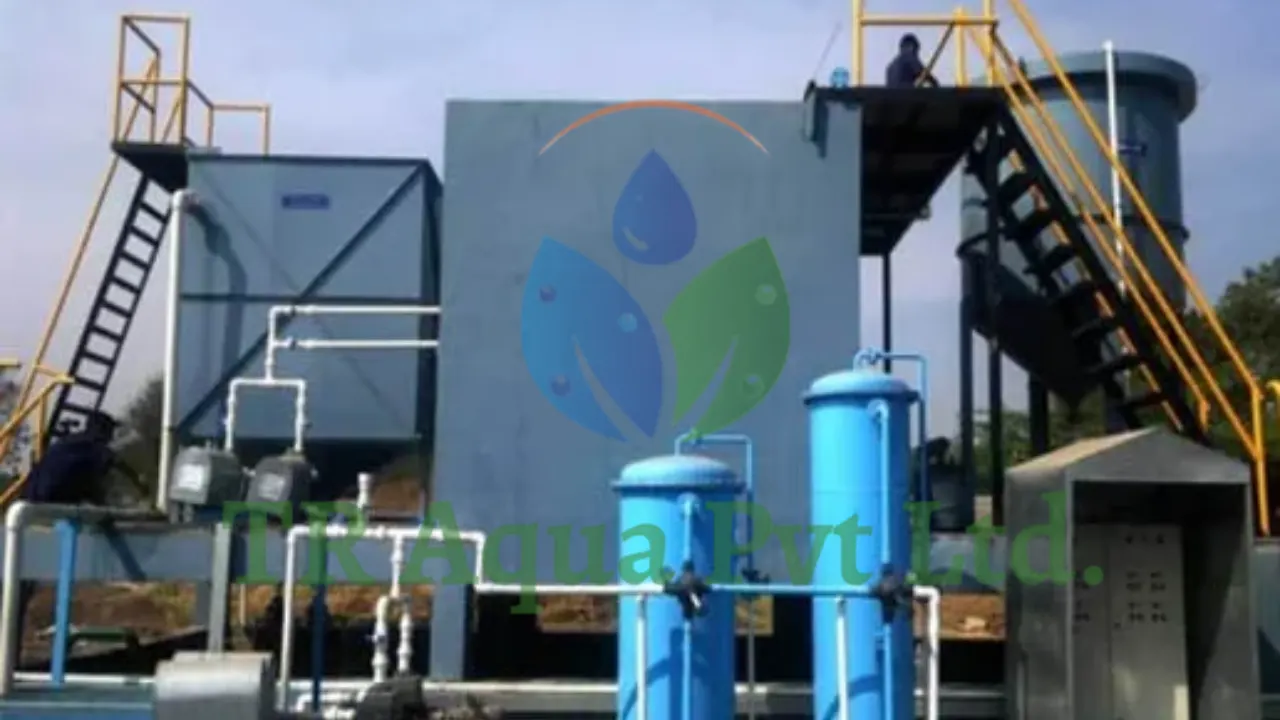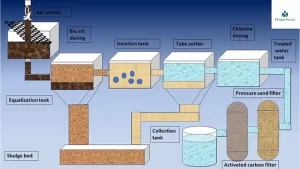Water is one of the most essential resources for life, but with increasing population and industrialization, the demand for clean water has been rising, while the quality of water sources has been declining. Sewage is wastewater that comprises large amounts of organic and inorganic solids, suspended particles, heavy metals, and other contaminants. Sewage treatment plants remove contaminants, microorganisms, and other pollutants from the wastewater. One of the critical steps in preserving water quality is treating the wastewater that is generated daily. A Sewage Treatment Plant (STP) plays a pivotal role in this process.
Also Read Us: What are the uses and Benefits of Water Softener Plant in Industries?
In this blog, we will explore the definition of an STP, the treatment process, the advantages and disadvantages of sewage treatment, and how TR Aqua Pvt. Ltd. is contributing to the advancement of wastewater treatment technologies.
What is a Sewage Treatment Plant (STP)?
A sewage treatment plant(STP) is a facility that receives waste from residential, commercial, and industrial sources and removes contaminants that harm water quality and endanger public health and safety when discharged into receiving systems or on land. Sewage Treatment Plants remove pollutants, contaminants, and hazardous substances from the sewage water and produce clean water. The treated water fulfills various water needs like agricultural, horticultural, and industrial. However, Sewage water treatment Plants come with several advantages and disadvantages. The treatment process ensures that the water is safe for human contact and that it doesn’t harm ecosystems when discharged into rivers, lakes, or oceans.
The Sewage Treatment Process
1. Preliminary Treatment:
The Sewage Treatment Plant process starts with the removal of large solids and particles through grates and screens. In the first stage, large debris like sticks, plastics, and other solid waste are removed from the incoming sewage through screening and grit removal. This prevents damage to the machinery and makes the process more efficient.
2. Primary Treatment:
In the primary treatment step, the sewage water runs into settling tanks; this allows the solid particles to settle at the bottom as sludge and lighter particles form a layer on the surface. The clear water, known as effluent, is separated from the settled solid particles. The sludged collected is further treated. The wastewater is allowed to sit in a large tank where solid particles, oils, and grease settle at the bottom, forming a sludge, while lighter substances rise to the surface. The floating waste is then skimmed off.
3. Secondary Treatment:
In this step, suspended biological and dissolved matter is removed from the wastewater. Secondary treatment focuses on the biological breakdown of organic matter. This stage uses bacteria and microorganisms to digest the remaining pollutants in the wastewater. The most common methods used are Activated Sludge Process (ASP), Trickling Filters, and Rotating Biological Contactors (RBCs). An additional separation method is employed to remove the microorganism from the water before discharging it.
4. Tertiary Treatment
Tertiary treatment is the final stage and is aimed at removing any remaining fine particles, nutrients (such as nitrogen and phosphorus), and pathogens. This may involve filtration, chemical treatment, or advanced technologies such as UV disinfection and membrane filtration.
5. Sludge Treatment
The sludge that accumulates in the primary and secondary treatment stages is processed separately. The sludge is either disposed of in a landfill, incinerated, or treated further to be reused as compost or for other purposes.
Advantages of Sewage Treatment Plants
- Environmental Protection: STPs help in protecting the environment by removing harmful contaminants from sewage water, preventing the pollution of water bodies and preserving aquatic life.
- Improved Public Health: A sewage Treatment Plant is a wastewater treatment system designed to remove pollutants from wastewater. It is an effective way to reduce pollutants from entering the environment and improve water quality.By eliminating harmful bacteria, viruses, and pathogens from wastewater, STPs contribute significantly to public health by reducing the risk of waterborne diseases.
- Water Recycling and Reuse: The treated water from STPs can be reused for non-potable purposes like irrigation, industrial cooling, or even cleaning. This helps conserve water, especially in areas facing water scarcity.
- Energy Generation: Some advanced STP systems have biogas plants that use the organic content of the wastewater to produce energy. This energy can be used to run the plant itself, making it more sustainable.
- Economic Benefits: Proper wastewater management enhances the quality of water available for communities, allowing for safe agricultural practices and better water management. This can lead to significant economic benefits in terms of resource conservation and cost savings.
Disadvantages of Sewage Treatment Plants
- High Initial Investment: Installing and maintaining a sewage treatment plant can be expensive and require a significant initial investment.The construction of an STP can be capital intensive, as it involves complex infrastructure, technologies, and equipment. The installation and setup costs can be a major barrier for smaller towns and cities.
- Ongoing Maintenance Costs: Regular maintenance, operation, and monitoring of the sewage treatment plant can be costly. The systems require skilled personnel and energy, which adds to the operational cost.
- Environmental Impact: While STPs help reduce pollution, they still produce sludge, which can be problematic if not treated or disposed of properly. Incorrect disposal of sludge can lead to land contamination.
- Space Constraints: Sewage treatment plants, especially large-scale ones, require a significant amount of space, which might not always be available, particularly in densely populated urban areas.
- Energy Consumption: STPs can consume large amounts of electricity, especially in advanced treatment stages like tertiary treatment or sludge treatment, which can impact their sustainability if not properly managed. Sewage treatment plants require significant amounts of energy to operate, which can lead to increased emissions of greenhouse gases.
How TR Aqua Pvt. Ltd. Contributes to Wastewater Treatment
At TR Aqua Pvt. Ltd., we specialize in providing cutting-edge Sewage Treatment Plant (STP) solutions for various industries and residential projects. We design and implement state-of-the-art STP systems that are efficient, eco-friendly, and cost-effective. Our expertise lies in offering customized solutions that address the unique wastewater treatment needs of our clients.
TR Aqua is one of the leading water and wastewater treatment company in India with services in the field of WTP manufacturing, WWTP manufacturing, RO Plant manufacturing, STP manufacturing, ETP manufacturing, Water Softeners, and much more.
With a focus on innovation and sustainability, TR Aqua Pvt. Ltd. integrates advanced technologies such as membrane bioreactors (MBRs), ultraviolet (UV) disinfection, and advanced filtration systems to deliver superior performance. By choosing our solutions, businesses and municipalities can reduce their environmental impact and contribute to a cleaner, healthier planet.
Conclusion
Sewage Treatment Plants (STPs) play an essential role in safeguarding water quality and public health. While the installation and maintenance of these systems come with certain costs, the benefits of reducing pollution, conserving water, and protecting the environment far outweigh the challenges. With the expertise and solutions offered by TR Aqua Pvt. Ltd., industries and communities can ensure effective and sustainable wastewater management, contributing to a greener and healthier future.




